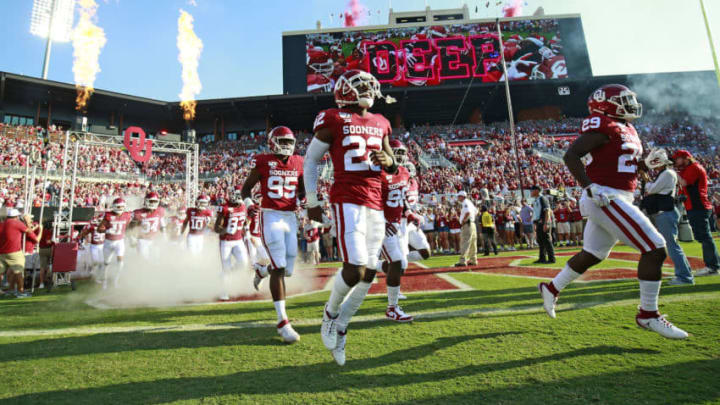Oklahoma football: What does ‘get better’ mean in Sooner vernacular?
By Chip Rouse

After all three of the Oklahoma football nonconference wins –all delivered with dominant offensive performances — the underlining sentiment we’ve heard is good but not good enough.
It’s been good, but “it’s still not anywhere where it needs to be,” are the words used by head coach Lincoln Riley to describe the state of the Sooners after one quarter of the 2019 college football season.
Oklahoma, the No. 5 team in the country in the Associated Press poll, has an extra week to get better before returning to action next weekend at home against Texas Tech in the Big 12 opener for both teams. But what exactly does “get better” mean?
The first thing any casual fan of Sooner football has to understand is that Oklahoma standards are much higher than other college football programs. If you aren’t playing for a Big 12 championship or contending for a national championship, the season cannot be considered successful. We’re talking about a program that has endured only 12 losing seasons in its 125-year history.
The Oklahoma offense, led this season by Alabama transfer Jalen Hurts, the third different quarterback to start for the Sooners in as many years, is averaging 677 yards per game, No. 1 in the country for a third straight year. That’s almost 100 more yards per game than either of the prior two years, but also after just three games.
OU also is averaging 55.7 points a game and outscoring its opponents by a margin of 36 points a game.
Hurts is the driver behind this year’s Sooner Ferrari offense, accounting for 418, or 62 percent, of the per-game yards. Hurts has completed 80 percent of his passes and is averaging over 100 yards rushing and close the 300 yards passing. Through three games, he has accounted for more touchdowns (13) than he has thrown incompletions (12), which is a remarkable stat.
After all three Oklahoma wins, Hurts has made a point of calling the team’s performance good, but not good enough: “We’ve done some really good things, but there are some things we really need to improve on.”
"“The stuff that we’ve displayed, that’s not complete football,” the OU quarterback said after the win he was instrumental in orchestrating over UCLA. “That’s not what we want to do. We can be better.”"
“It’s not about numbers,” Hurts told Jason Kersey of The Athletic this week. “It’s about execution, being better in out execution.”
But what will better look like? The execution has not been perfect, but it’s been pretty darn good. If it gets much better, it will be almost impossible to stop for opposing defenses.
Oklahoma Sooners Football
Perfection is what Alabama coach Nick Saban coaches to and what his team’s chase seemingly every season. You can see that coming through in how Hurts views the game, having spent three seasons under Saban at Alabama.
One area where the Sooners can make some improvement, ironically, is having Hurts run the ball fewer times. He is averaging nearly 13 carries per game. His 38 total rushing attempts are just six fewer than the combined total of OU’s two primary running backs: Trey Sermon and Kennedy Brooks. Hurts has always been an better runner than a passer, and he’s built like a running back, which gives him somewhat of an advantage when he tucks the ball and takes off on the ground.
But the Sooners need him for the entire season, and when he fails to slide, which he does often, he puts himself at increased risk for injury. Runs created out of broken plays are one thing, but too many designed runs only increases the risk of injury to the team’s most important player.
The Sooners have a deep and talented running back stable, so there is really no reason for Hurts to lead the team in rushing, which he does currently (almost 200 yards more than the next closest Sooner).
Eliminating penalties that put the offense behind the chains and often negate big plays is another area where the Sooners can definitely get better. OU is averaging 83 penalty yards per game, and a good number have come on offense.
As good as the Sooner passing game is — 16 different receivers have caught passes already this season — it has not been getting the production it should have out of its best receiver. CeeDee Lamb caught just one pass in the UCLA game, a 39-yarder that went for a touchdown, and he has just nine catches for 229 yards through three games. That’s underutilization for a player who is a preseason All-America candidate and caught 65 passes for 1,158 yards a year ago.
The reality is the offense can always stand to get better because it will never reach perfection, but Oklahoma’s offensive execution and efficiency is much further along on that continuum than the defense.
When head coach Lincoln Riley — and, to a lesser extent, his quarterback, Hurts — is talking about the Sooners being “nowhere near where they need to be,” he isn’t just speaking of the team’s offensive capability; he’s also referring to work that needs to be done to improve on defense as well as special teams.
Making adjustments and improvement is part of the game. As they say, if you aren’t getting better, you’re getting worse. Riley has made it clear: The latter is not an option.